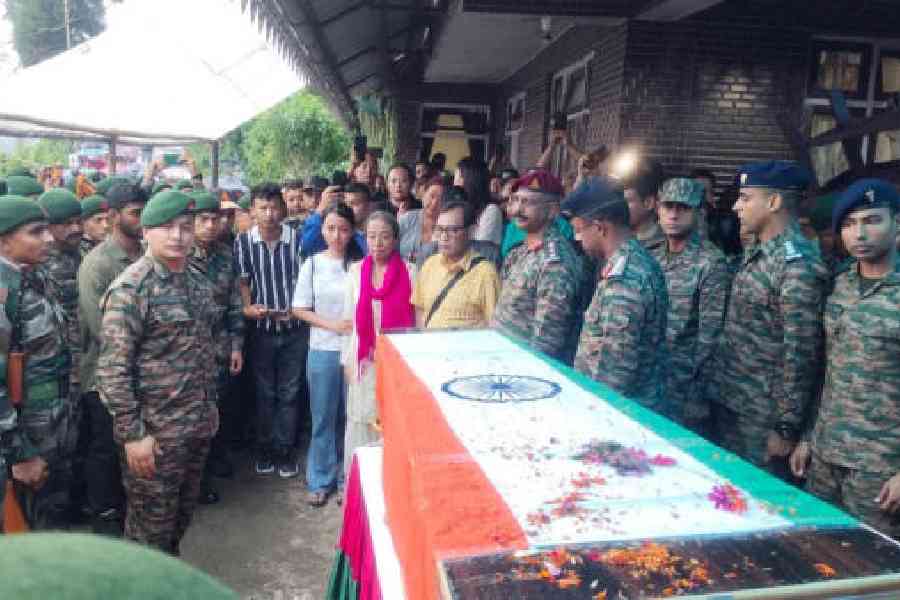Captain Brijesh Thapa, who is the 182nd soldier from the Darjeeling region to sacrifice his life for the country since India’s independence, was given a tearful farewell by thousands of people who lined up along the road from Siliguri to Darjeeling on Thursday.
The journey between the two places normally takes around two-and-a-half hours. On Thursday, it took nearly nine hours for the mortal remains of Captain Brijesh Thapa to reach Bara Ging in Darjeeling.
“If I had another son, I would still send him to the armed forces,” said mother Nilima Thapa. Captain Brijesh, 27, a third-generation army officer, was killed by terrorists in Jammu and Kashmir on Monday night.
Nilam, her husband Col. (retd) Bhuwanesh Thapa and their daughter Nikhita accompanied the body from Bengdubi in Siliguri to their native village. Thousands of people lined up at more than a dozen places to offer their respects to the martyr.
Sources in the Darjeeling Zilla Sainik Board said Captain Brijesh was the 182nd soldier from the Darjeeling district to lay down his life for the country since 1947.
The board looks after the welfare of ex-servicemen in the Darjeeling and Kalimpong districts and considers the two districts as single.
“This figure is according to our records and also includes that of Kalimpong,” said a source. The Kalimpong district was carved out of the Darjeeling district on February 14, 2017.
Dr Purushottam Bhandari, a professor of Jagiroad College in Guwahati, who had done extensive research on Indian Gorkhas, said hundreds of Gorkhas had laid down their lives for India.
“I have recorded the names of 996 Gorkhas, including Captain Brijesh, who have laid down their lives for India from 1891 till date,” Bhandari told The Telegraph over the phone from Guwahati. The professor has travelled across the length and breadth of the country to record the names.
Niranjan Singh Chhetri from Manipur was hanged by the British on June 8, 1891, for waging a war against the British and he was the first Gorkha martyr in India.
Bhandari, however, said that it was difficult to differentiate between the Gorkhas of Nepal and India during the British period. But from 1947 onwards, he has only included Indian Gorkhas in his list.
“I have not included the names of soldiers from Nepal in the list post-1947. I have not got records of Gorkhas who died during Operation Blue Star (that was carried out to flush militants out of Golden Temple in Amritsar in 1984) either,” said Bhandari.
The steely grit of Gorkhas had been first recognised internationally during the Anglo-Nepalese war (1814-16) between the East India Company and the Gorkha Kingdom. Even though the Gorkhas lost the war, the valour of the community impressed the British to the extent that they decided to recruit “Gurkhas” into the military.
At the time of India’s Independence in 1947, the British had 10 Gorkha regiments, which had served with distinction in all major wars that the British had fought.
After Independence, a pact generally called the “Tripartite Agreement (TPA)” was signed by the UK, India and Nepal in 1947. Under the deal, Nepal agreed to allow Gorkha troops in the armies of the UK and India.
Following the agreement, six out of 10 Gorkha regiments became part of the Indian Army and the remaining four went with the British army. However, some Gorkha soldiers refused to join the British army. To retain them, the Indian Army raised the 11 Gorkha Rifles.
The present Gorkha regiment of the Indian army has 60 per cent of recruits from Nepal and the remaining are Indian Gorkhas. However, after the introduction of the Agniveer scheme, Nepal stopped sending its citizens for recruitment into the Indian army. The UK still recruits “Gurkhas” but only Nepal citizens are eligible to join.











